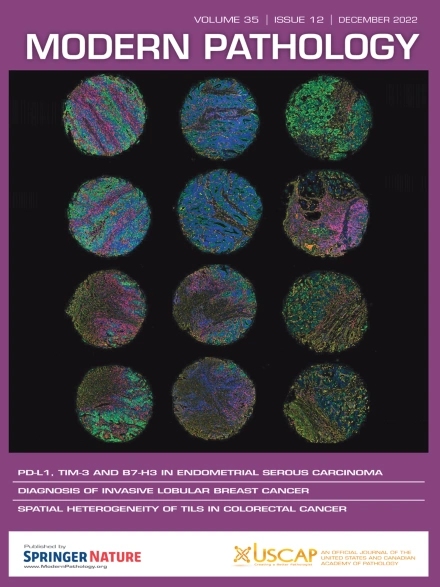GLI1-Altered Mesenchymal Tumor—Multiomic Characterization of a Case Series and Patient-Level Meta-analysis of One Hundred Sixty-Seven Cases for Risk Stratification
IF 7.1
1区 医学
Q1 PATHOLOGY
引用次数: 0
Abstract
GLI1-altered mesenchymal tumors have recently emerged as a distinctive group of neoplasms characterized by GLI1 fusions or amplifications. Although there is clearly metastatic potential, the clinicopathologic features predicting for metastasis are currently unknown. Herein, we present 6 cases of GLI1-altered mesenchymal tumors with multiomics analysis. The median patient age was 50 years (range, 3-68 years). They arose from the extremities and trunk (2/6), head and neck region (2/6), and gastrointestinal tract (2/6). Histologically, they featured uniform round to ovoid cells with nested architecture and a rich vascular network. One case displayed abundant multinucleated giant cells. All stained positive for GLI1 (5/5) and CD56 (6/6). Molecularly, they featured GLI1 fusion (5/6) and amplification (1/6). Fusion partners included ACTB (3/5), TXNIP (1/5), and novel TUBA1B (1/5). Multiomics analysis revealed they possessed distinct expression and epigenomic profiles. All the 6 cases had follow-up information, with 5 of them having no evidence of disease at a median follow-up of 30 months (range, 17.3-102 months), and 1 case being died of disease with regional neck lymph node and bilateral lung metastasis at 81.5 months of follow-up. By incorporating cases reported in the literature, we analyzed clinicopathologic features of a total of 167 cases predictive of malignant behavior. We found that size ≥6 cm and mitotic count ≥5 per 10 high-power fields are predictive of metastasis. Cases with both high-risk features had significantly poorer survival. This study expands the literature database of GLI1-altered mesenchymal tumors and identifies features that can be used for risk stratification.
GLI1-altered间质瘤--一个病例系列的多组学特征和对167个病例进行的患者水平元分析,以进行风险分层。
GLI1改变的间质肿瘤是最近出现的一类以GLI1融合或扩增为特征的独特肿瘤。虽然这种肿瘤具有明显的转移潜能,但预测转移的临床病理特征目前尚不清楚。在此,我们通过多组学分析介绍了6例GLI1改变的间叶肿瘤。患者的中位年龄为 50 岁(3 至 68 岁)。它们分别来自四肢和躯干(2/6)、头颈部(2/6)和胃肠道(2/6)。从组织学角度看,它们具有均匀的圆形至卵圆形细胞,巢状结构和丰富的血管网络。其中一个病例显示出大量多核巨细胞。所有病例的 GLI1(5/5)和 CD56(6/6)染色均呈阳性。分子上,它们具有 GLI1 融合(5/6)和扩增(1/6)的特征。融合伙伴包括 ACTB(3/5)、TXNIP(1/5)和新型 TUBA1B(1/5)。多组学分析显示,它们具有不同的表达和表观基因组特征。所有6个病例都有随访资料,其中5个病例在中位随访30个月(17.3至102个月)时无疾病迹象,1个病例在随访81.5个月时因区域性颈部淋巴结和双侧肺转移而死亡。结合文献报道的病例,我们分析了总共 167 例可预测恶性行为的临床病理特征。我们发现,肿瘤大小≥6厘米和每10个高倍视野有丝分裂计数≥5个可预测转移。具有这两个高危特征的病例生存率明显较低。这项研究扩展了GLI1改变间质肿瘤的文献数据库,并确定了可用于风险分层的特征。
本文章由计算机程序翻译,如有差异,请以英文原文为准。
求助全文
约1分钟内获得全文
求助全文
来源期刊

Modern Pathology
医学-病理学
CiteScore
14.30
自引率
2.70%
发文量
174
审稿时长
18 days
期刊介绍:
Modern Pathology, an international journal under the ownership of The United States & Canadian Academy of Pathology (USCAP), serves as an authoritative platform for publishing top-tier clinical and translational research studies in pathology.
Original manuscripts are the primary focus of Modern Pathology, complemented by impactful editorials, reviews, and practice guidelines covering all facets of precision diagnostics in human pathology. The journal's scope includes advancements in molecular diagnostics and genomic classifications of diseases, breakthroughs in immune-oncology, computational science, applied bioinformatics, and digital pathology.
 求助内容:
求助内容: 应助结果提醒方式:
应助结果提醒方式:


